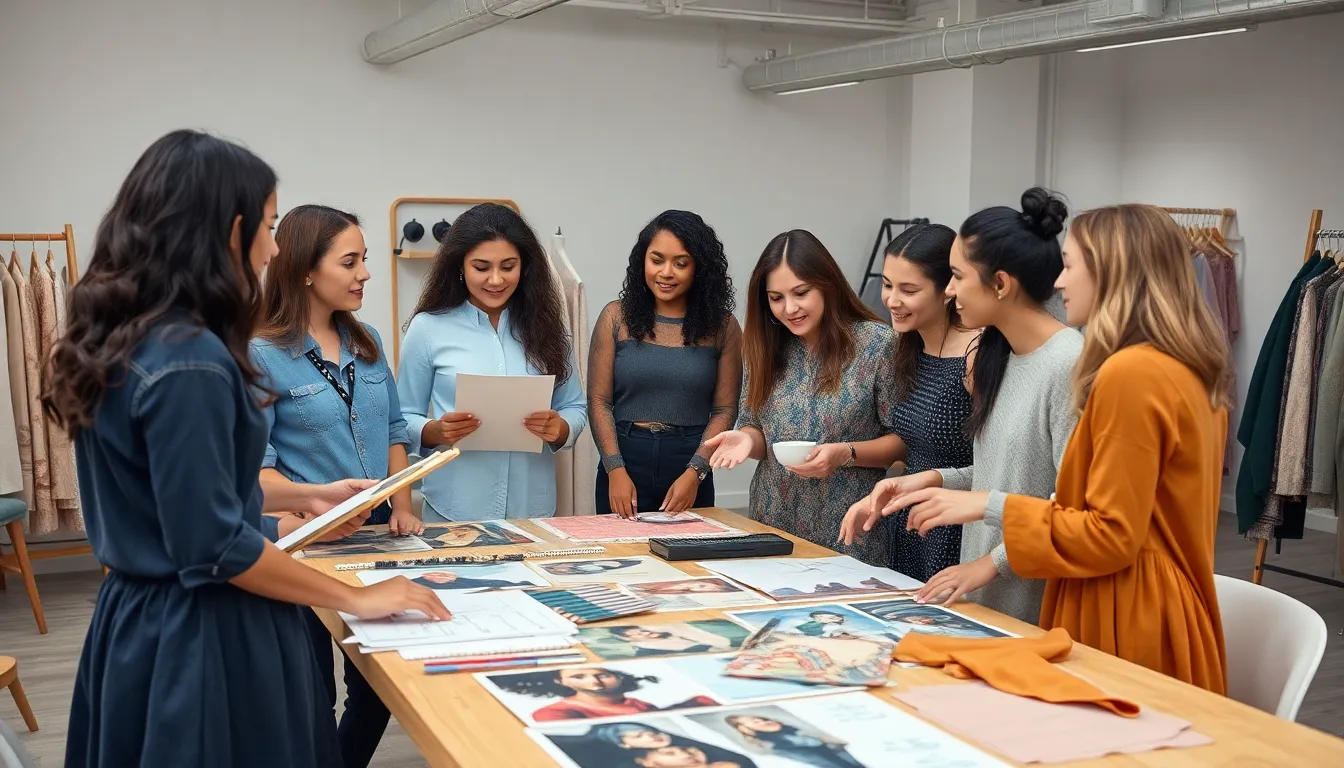In the fast-paced world of fashion, internships aren’t just a rite of passage; they’re the golden ticket to turning dreams into reality. Imagine strutting into the industry armed with hands-on experience that not even the most stylish runway can overshadow. Fashion design internships are the perfect blend of creativity and practicality, where aspiring designers can unleash their inner genius while sipping lattes and dodging fabric swatches.
Table of Contents
ToggleOverview of Fashion Design Internships
Fashion design internships serve as pivotal opportunities for aspiring designers. These programs offer hands-on experience, integrating creativity with real-world skills. Interns engage directly with the design process, gaining insights into industry practices and trends.
Sourcing fabrics and understanding color theory forms a crucial part of an intern’s role. Specific tasks often include assisting in sketching designs, preparing presentations, and helping with fittings. Interns also connect with industry professionals, expanding their network within the fashion community.
In terms of duration, most internships last from three to six months. Various companies, from established fashion houses to emerging brands, offer these positions. Each internship varies, tailored to provide a unique learning experience.
Compensation for internships can differ significantly. Some positions offer stipends, while others provide college credit. Emerging designers should research opportunities thoroughly to find the best fit for their career aspirations.
Overall, fashion design internships represent a critical stepping stone towards a successful career in fashion. They combine practical learning with professional growth, equipping interns with essential tools and experiences. With dedication and effort, these internships can lead to full-time employment in the competitive fashion landscape.
Benefits of Fashion Design Internships

Fashion design internships offer numerous advantages that enhance an aspiring designer’s career trajectory. These opportunities enable hands-on experience while fostering the development of essential skills in a competitive landscape.
Skill Development
Internships allow designers to hone a variety of skills crucial for a successful career. Time management becomes vital as interns juggle multiple tasks, such as sketching, fabric selection, and preparing presentations. Research skills also improve as interns gather materials and trends that influence designs. Visual communication gains emphasis, helping individuals learn how to effectively present ideas to teams or clients. Problem-solving skills become apparent as interns navigate and address challenges in the design process. Continuous feedback from mentors leads to significant growth, ensuring that each intern emerges more competent and industry-ready.
Networking Opportunities
Internships serve as a gateway to build professional connections within the fashion industry. Exposure to seasoned professionals offers insights into industry standards and expectations. Interactions with peers create a collaborative environment that often leads to friendships and future collaborations. Attending fashion shows, trade events, or studio visits expands an intern’s network, connecting them with potential employers or mentors. These relationships provide valuable references for future job applications or recommendations. Access to industry events can guide interns toward discovering job openings and trends, significantly enhancing their career prospects.
Types of Fashion Design Internships
Fashion design internships are diverse, offering unique experiences tailored to different career goals and skill sets. Understanding the types of internships helps aspiring designers identify the best fit for their aspirations.
Paid vs. Unpaid Internships
Paid internships provide financial compensation, making them a desirable option for many. These positions often reflect industry standards, offering stipends or hourly wages. In contrast, unpaid internships typically provide academic credit or valuable experience. Such opportunities are common in competitive fashion houses aiming to cultivate talent with minimal financial barriers. Evaluating both types is essential for potential interns to align choices with financial and career objectives.
Remote vs. On-site Internships
Remote internships grant flexibility, allowing work from various locations. This arrangement suits individuals balancing other commitments or geographical constraints. On-site internships immerse interns in the creative environment of fashion studios or design offices. These positions foster direct collaboration and mentorship, enhancing hands-on learning. Selecting between remote and on-site options hinges on personal preferences, career goals, and logistical considerations.
How to Secure a Fashion Design Internship
Securing a fashion design internship involves a strategic approach that showcases an aspiring designer’s skills and creativity. Focusing on essential elements like portfolios and resumes can significantly enhance one’s chances.
Building a Strong Portfolio
Creating a strong portfolio stands as a crucial step for aspiring designers. A collection should showcase a range of works, including sketches, finished designs, and projects demonstrating versatility. Including personal projects or coursework adds depth and diversity. Quality matters; high-resolution images and clear descriptions enhance presentation. Tailoring the portfolio to align with the specific internship enhances its relevance. Highlighting innovative designs indicates creativity and originality.
Crafting an Effective Resume
An effective resume captures attention quickly and reflects relevant skills. Start with contact information and a concise objective that outlines career goals. Focus on education, listing degrees or certifications that emphasize fashion design knowledge. Include relevant work experience, volunteering, or projects that demonstrate practical skills. Action verbs energize descriptions and illustrate contributions effectively. Keep the format clean and professional to maintain clarity and readability. Tailoring each resume to match the internship requirements boosts its impact.
Challenges Faced in Fashion Design Internships
Interns in the fashion industry encounter numerous challenges that can impact their experience and growth. Understanding these challenges assists aspiring designers in preparing for the realities of their internships.
Competitive Nature of the Industry
The fashion industry ranks among the most competitive fields. Interns compete against countless candidates for limited positions, making it vital to stand out. Those selected often demonstrate a unique blend of creativity and relevant skills. Aspiring designers must continuously refine their portfolios to showcase distinctive works. Networking plays a crucial role in gaining visibility within this crowded space. Additionally, industry connections can facilitate introductions to key decision-makers, improving chances of securing desired internships.
Work-life Balance
Maintaining a work-life balance proves challenging during internships. Interns often face demanding schedules that extend beyond standard hours. Long weeks consisting of intricate tasks can lead to exhaustion. Pressure to meet tight deadlines may compromise personal time and well-being. Establishing boundaries becomes essential for managing stress and preventing burnout. Interns benefit by practicing effective time management skills, prioritizing tasks, and seeking guidance from mentors. Structured approaches foster a healthier balance, ensuring a more productive internship experience.
Fashion design internships play a vital role in shaping the careers of aspiring designers. These experiences not only provide practical skills but also foster creativity and professional growth. By engaging in hands-on tasks and receiving mentorship, interns gain invaluable insights into the industry.
The diverse opportunities available allow individuals to choose paths that align with their goals, whether through paid or unpaid positions. Networking and skill development further enhance their prospects in this competitive field. With dedication and the right strategies, interns can transform these experiences into successful careers in fashion, paving the way for future achievements.




